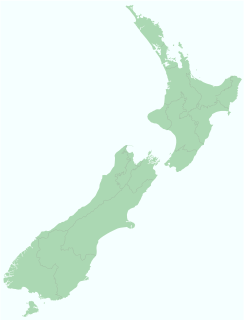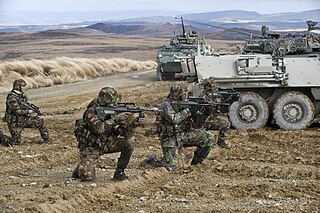 W
WThe New Zealand Army is the land component of the New Zealand Defence Force and comprises around 4,500 Regular Force personnel, 2,000 Territorial Force personnel and 500 civilians. Formerly the New Zealand Military Forces, the current name was adopted by the New Zealand Army Act 1950. The New Zealand Army traces its history from settler militia raised in 1845.
 W
WABCANZ Armies is a program aimed at optimizing interoperability and standardization of training and equipment between the armies of Australia, Canada, New Zealand, the United Kingdom, and the United States, plus the United States Marine Corps and the Royal Marines. Established in 1947 as a means to capitalize on close cooperation between the United States, United Kingdom, and Canada during World War II, the program grew to include Australia and New Zealand.
 W
WChief of Army (CA) is the effective commander of the New Zealand Army, responsible to the Chief of Defence Force (CDF) for raising, training and sustaining those forces necessary to meet agreed government outputs. The CA acts as principal advisor to the CDF on Army matters, though for operations the Army's combat units fall under the command of the Land Component Commander, Joint Forces New Zealand. The rank associated with the position is major general, and CAs are generally appointed on a three-year term.
 W
WCoastal fortifications were constructed in New Zealand in two main waves: around 1885 as a response to fears of an attack by Russia, and in World War II due to fears of invasion by the Japanese.
 W
WFort Ballance is a former coastal artillery battery on Point Gordon on Wellington's Miramar Peninsula.
 W
WThis is a list of equipment used by the New Zealand Army
 W
WThe New Zealand Army Band is a brass band that primarily provides musical support for the New Zealand Army at all state and ceremonial occasions. It was founded in 1964 by Captain James Donald Carson (1935–2008) of the Royal New Zealand Infantry Regiment.
 W
WThe New Zealand Army rugby team of 1919 was a rugby union team which represented New Zealand after the end of the First World War. Although spoken of as a single team, there were several New Zealand Services teams playing in Britain at the conclusion of the War. The most notable being the touring Army XV who played a series of games throughout Great Britain and France, including an internationally recognised match against the Wales national team. With the introduction of the King's Cup; a services tournament between forces from Australia, Britain, Canada, New Zealand and South Africa, the team split intself in two. The 'A' Team taking part in the King's Cup, while the 'B' team continued touring against club and county opponents.
 W
WMaungauika is a volcano forming a headland called North Head at the east end of the Waitematā Harbour in Auckland, New Zealand, in the suburb of Devonport. Known for its sweeping views over the harbour and the Hauraki Gulf, since 1885 the head was mainly used by the military as a coastal defence installation, which left a network of accessible old bunkers and tunnels as its legacy, forming part of the attraction. The site was protected as part of Hauraki Gulf Maritime Park in 1972 and listed as a Category I historic place in 2001. As part of a 2014 Treaty of Waitangi claim settlement the volcanic cone was officially named Maungauika and the reserve renamed Maungauika / North Head Historic Reserve. Maungauika is the Māori word for Mountain of Uika.
 W
WA slouch hat is a wide-brimmed felt or cloth hat most commonly worn as part of a military uniform, often, although not always, with a chinstrap. It has been worn by military personnel from many different nations including Australia, Ireland, Britain, India, New Zealand, Southern Rhodesia, France, the United States, the Confederate States, Germany and many others. Australia and New Zealand have had various models of slouch hat as standard issue headwear since the late Victorian period.
 W
WStony Batter is a historic defence installation at the northeastern end of Waiheke Island, Auckland, New Zealand. It is sited within a 50-acre scenic reserve of the same name, owned by the New Zealand Department of Conservation (DOC). The park serves double duty as a historical and nature reserve, containing unusual rock formations, three significant bush blocks and three concrete gun emplacements with an extensive tunnel system, reputed to be the largest in New Zealand.
 W
WThis article describes the current structure of the New Zealand Army. It includes the army's order of battle and the headquarters locations of major units.
 W
WWrights Hill Fortress is a counter bombardment coastal artillery battery in the Karori suburb of Wellington, New Zealand. It was built between 1942 and 1947 and is predominantly underground, with numerous tunnels linking the war shelters, gun emplacements, magazines, plotting rooms and engine room - which are, at some points, over 50 feet underground. The fort was intended to house three 9.2" Mk. XV guns, but only two guns were installed and the fort never saw action. After World War II was over, fort commanders fired both of the guns. The fall of the shot was observed in Cook Strait and these test firings were deemed a success. In 1960, somewhat ironically, both of the guns were sold to the Japanese as scrap metal, the very nation Wrights Hill Fortress was constructed to defend Wellington against. The design of the fort is similar to the Stony Batter and Whangaparaoa 9.2" Mk. XV batteries, near Auckland.